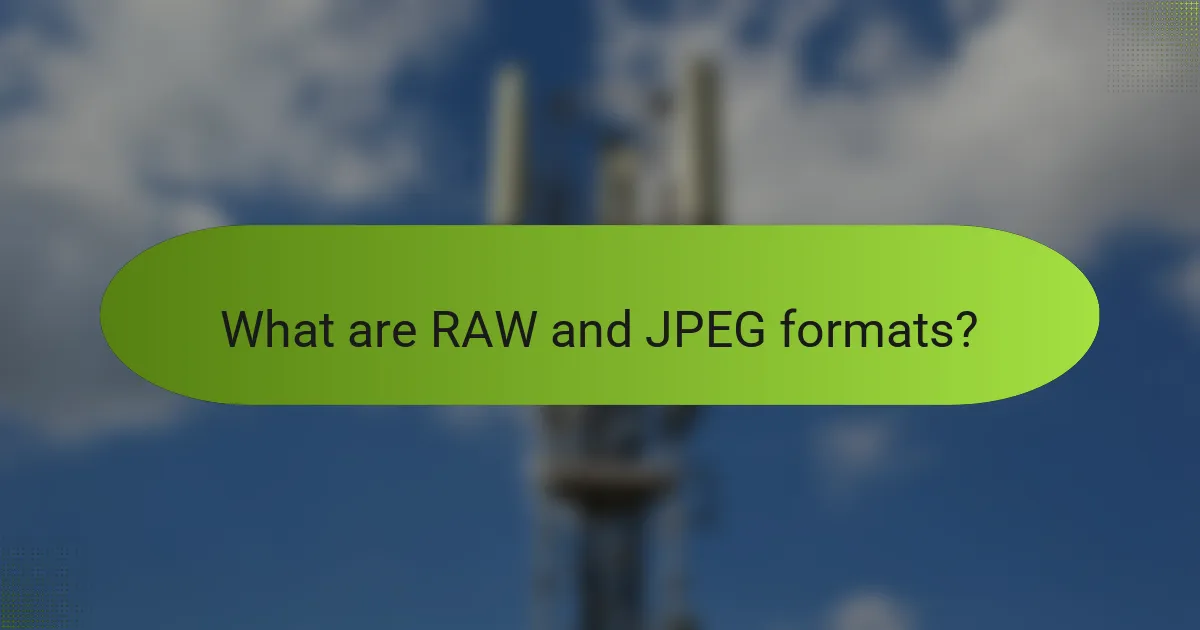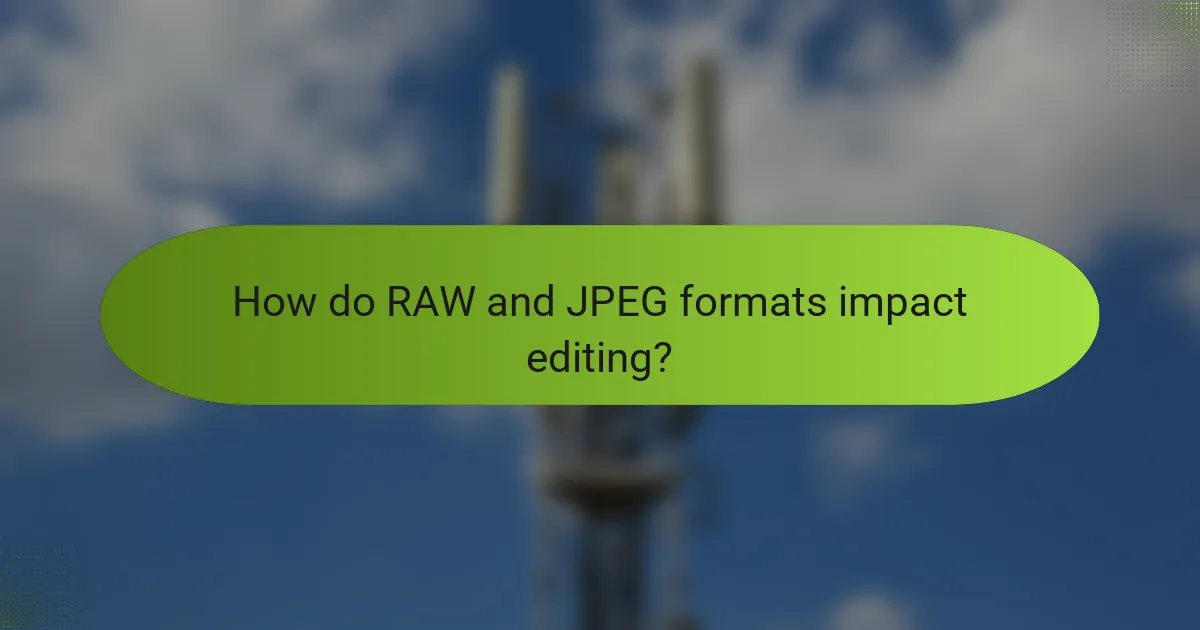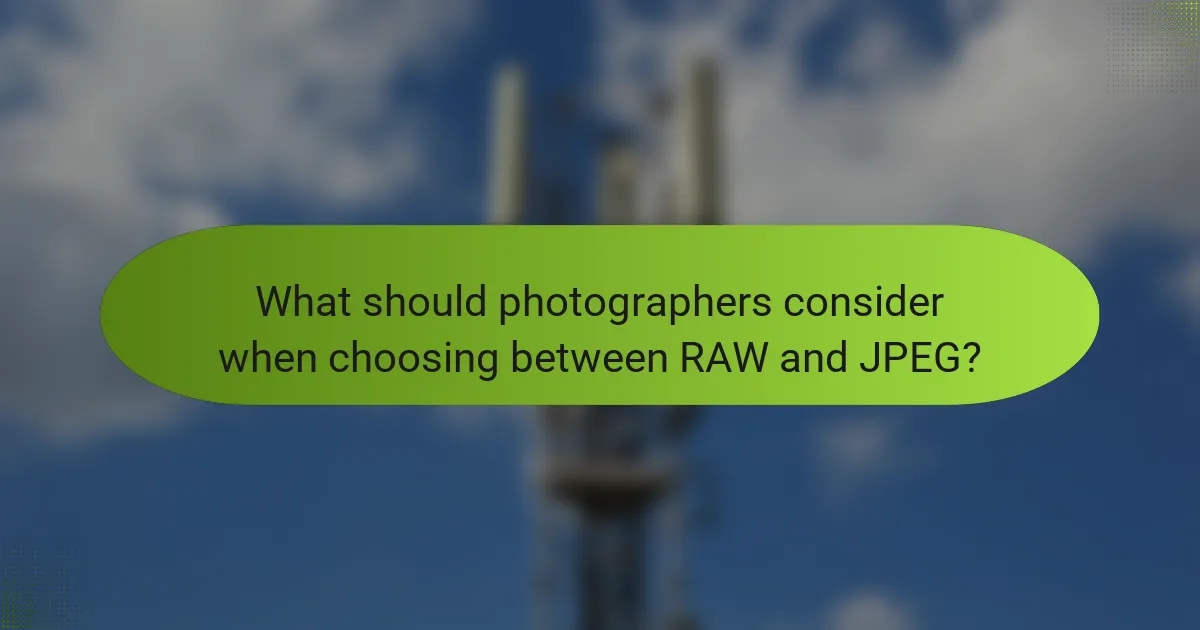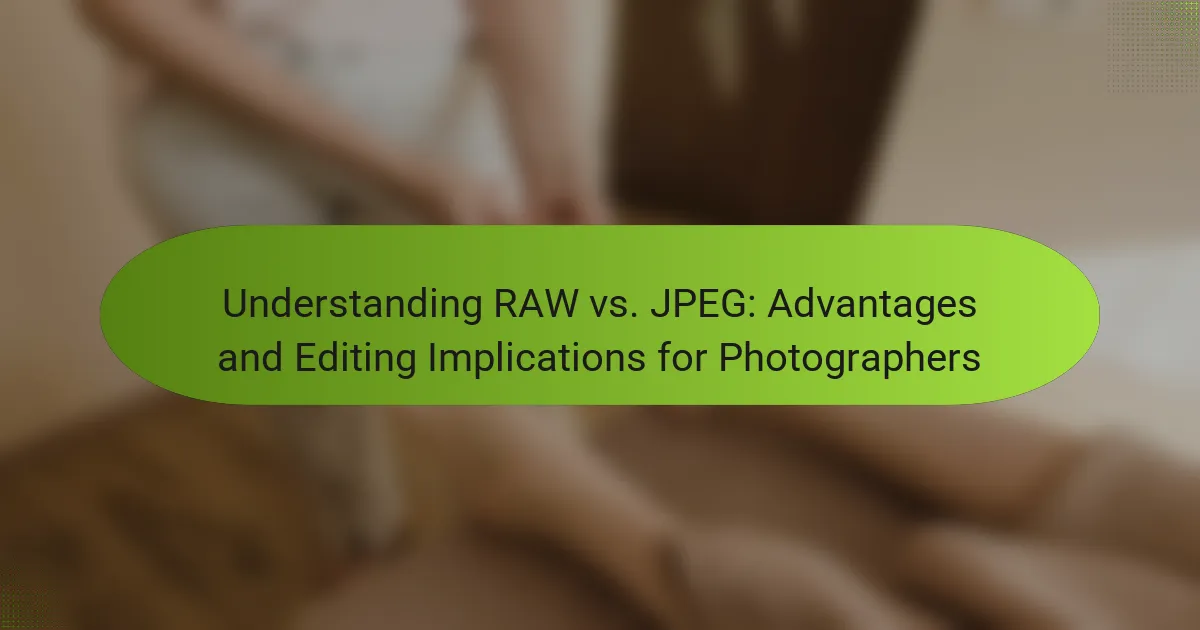
What are RAW and JPEG formats?
RAW and JPEG are two types of image file formats used in photography. RAW files contain unprocessed data from a camera’s sensor. This format allows for greater flexibility in post-processing. JPEG files are compressed images that maintain a balance between quality and file size. Unlike RAW, JPEG files are processed and ready for use immediately. RAW format is preferred for professional editing due to its higher quality and detail retention. JPEG is often used for everyday photography due to its smaller size and compatibility with various devices.
How do RAW and JPEG differ in terms of image quality?
RAW files offer superior image quality compared to JPEG files. RAW captures more detail and retains more information from the camera’s sensor. This results in greater dynamic range and color depth. JPEG, on the other hand, compresses image data, leading to a loss of detail. JPEG files are processed in-camera, which can result in artifacts and reduced quality. In contrast, RAW files allow for extensive post-processing without degrading image quality. Studies show that RAW files can contain up to 14 bits of color information, while JPEGs are limited to 8 bits. This difference significantly affects the ability to edit images without losing quality.
What attributes define RAW format?
RAW format is a digital image file that captures unprocessed data from a camera’s sensor. It retains a wide dynamic range and high color depth. This format allows for extensive post-processing without loss of quality. RAW files are larger than JPEGs due to their uncompressed nature. They contain more detail, making them ideal for professional photography. Each camera brand may have its own RAW format, such as CR2 for Canon or NEF for Nikon. RAW files require specific software for editing, as they are not universally compatible. This format provides maximum flexibility in adjusting exposure, contrast, and color balance.
What attributes define JPEG format?
JPEG format is defined by its lossy compression, color depth, and file extension. The lossy compression reduces file size by discarding some image data. This makes JPEGs ideal for web use and storage. JPEG supports 24-bit color depth, allowing for over 16 million colors. The standard file extension for JPEG images is .jpg or .jpeg. JPEG files are widely compatible across devices and software. They also include a built-in metadata format for additional information. These attributes make JPEG a popular choice for photographers and casual users alike.
Why do photographers choose one format over the other?
Photographers choose one format over the other based on specific needs and desired outcomes. RAW format provides greater flexibility for editing due to its higher bit depth and uncompressed nature. This allows for more extensive adjustments in exposure, color, and detail. JPEG, on the other hand, offers smaller file sizes and faster processing times. It is suitable for quick sharing and storage, making it ideal for casual photography. The choice often depends on the intended use of the images. For professional work requiring high-quality edits, RAW is preferred. For everyday snapshots or quick uploads, JPEG is often sufficient.
What are the advantages of using RAW?
RAW files offer several advantages for photographers. They provide higher image quality due to less compression. RAW retains more detail in highlights and shadows compared to JPEG. This allows for greater flexibility in post-processing. Photographers can adjust exposure, white balance, and contrast more effectively. The bit depth of RAW files is typically higher, allowing for smoother color transitions. Additionally, RAW files contain all the data captured by the camera’s sensor. This results in better overall image fidelity.
What are the advantages of using JPEG?
JPEG offers several advantages for photographers. It provides efficient compression, significantly reducing file sizes. This compression allows for easier storage and faster uploads. JPEG files are widely compatible with various devices and software. The format supports 24-bit color, enabling vibrant images. JPEG also features adjustable quality settings, allowing users to balance image quality and file size. Additionally, it is ideal for sharing online due to its small size. According to Adobe, JPEG is the most commonly used image format on the web.

How do RAW and JPEG formats impact editing?
RAW formats provide more flexibility in editing compared to JPEG formats. RAW files retain all image data captured by the camera sensor. This allows for extensive adjustments in exposure, white balance, and color grading without losing quality. JPEG files, however, are compressed and discard some data during saving. This compression limits the extent of adjustments that can be made. For instance, altering exposure in a JPEG can introduce artifacts and reduce image quality. In contrast, editing a RAW file maintains image integrity even with significant changes. Therefore, photographers often prefer RAW for detailed post-processing tasks.
What editing capabilities do RAW files offer?
RAW files offer extensive editing capabilities due to their unprocessed data. They allow adjustments to exposure, white balance, and contrast without quality loss. Photographers can manipulate shadows and highlights more effectively. Additionally, RAW files support higher bit depths, providing more color information. This results in smoother gradients and less banding. RAW editing software enables non-destructive edits, preserving the original file. The flexibility of RAW files is essential for professional photography workflows. These capabilities make RAW the preferred format for high-quality image editing.
How does dynamic range in RAW affect post-processing?
Dynamic range in RAW files significantly enhances post-processing capabilities. RAW files capture a wider range of light and color information compared to JPEGs. This allows for more detailed adjustments in exposure, contrast, and color grading. Photographers can recover highlights and shadows without introducing noise or artifacts. For instance, RAW files can retain details in bright skies and dark shadows simultaneously. This characteristic is crucial for high-contrast scenes. Studies show that images with greater dynamic range result in more visually appealing edits. Thus, a higher dynamic range in RAW files directly benefits the overall quality of post-processed images.
What color correction options are available for RAW images?
Color correction options for RAW images include adjusting white balance, exposure, contrast, and saturation. White balance allows correction of color temperature to achieve accurate colors. Exposure adjustments help in correcting brightness and shadow details. Contrast settings enhance the difference between light and dark areas in an image. Saturation adjustments increase or decrease the intensity of colors. These options provide photographers with greater flexibility in post-processing compared to JPEG files. RAW images retain more data, allowing for more extensive adjustments without loss of quality.
What limitations do JPEG files present in editing?
JPEG files present significant limitations in editing due to their lossy compression. This compression reduces image quality by discarding data, which affects color accuracy and detail. JPEG files have a limited dynamic range, making it difficult to recover highlights and shadows. Additionally, repeated saving of JPEGs leads to further degradation of image quality. The color depth of JPEGs is typically 8-bit, restricting the number of colors and gradients. These factors hinder extensive editing, such as aggressive cropping or significant adjustments to exposure and color balance. Consequently, photographers often prefer RAW formats for greater flexibility in post-processing.
How does compression affect image quality in JPEGs?
Compression in JPEGs reduces file size but can degrade image quality. This degradation occurs due to lossy compression, which discards some image data. The more compression applied, the more detail and color information may be lost. Artifacts such as blurring and pixelation can appear in highly compressed images. JPEG compression is particularly noticeable in areas of high contrast or fine detail. A study by the International Journal of Image Processing found that compression ratios above 10:1 significantly impact perceived quality. Therefore, while compression is useful for storage, it compromises visual fidelity.
What editing adjustments are more challenging with JPEGs?
Editing adjustments that are more challenging with JPEGs include significant color correction, exposure adjustments, and noise reduction. JPEGs use lossy compression, which reduces image quality and limits editing flexibility. This compression results in a loss of detail, making it difficult to recover highlights and shadows without introducing artifacts. Color adjustments can lead to banding due to limited color depth in JPEGs. Additionally, sharpening can amplify noise, further degrading image quality. These limitations contrast with RAW files, which retain more data for extensive editing.

What should photographers consider when choosing between RAW and JPEG?
Photographers should consider image quality, file size, and editing flexibility when choosing between RAW and JPEG. RAW files retain more detail and dynamic range, which is crucial for post-processing. JPEG files are compressed, leading to smaller file sizes, but they lose some image information. RAW formats allow for greater adjustments in exposure and color without degradation. JPEGs, while easier to share and store, limit editing options due to their compression. Photographers should also think about their workflow and storage capabilities. RAW files require more storage space and processing power. In contrast, JPEGs are more convenient for quick sharing and viewing.
What factors influence the choice of format based on shooting conditions?
Shooting conditions significantly influence the choice of format between RAW and JPEG. Light availability affects dynamic range and detail retention. In low light, RAW captures more detail and reduces noise, making it preferable. Conversely, in bright conditions, JPEG may suffice due to its smaller file size and faster processing. The subject’s motion plays a role as well. Fast-moving subjects benefit from JPEG’s quicker write times, preventing motion blur. Additionally, the intended use of images matters. For professional work requiring extensive editing, RAW is ideal. In contrast, JPEG is suitable for quick sharing or casual use. Environmental factors like humidity and temperature can also influence format choice, as RAW files are more prone to data loss in adverse conditions.
How does storage capacity affect format selection?
Storage capacity significantly influences format selection in photography. Higher storage capacity allows photographers to choose RAW formats. RAW files are larger and retain more detail than JPEGs. This increased detail is beneficial for extensive editing. Conversely, limited storage capacity often leads to selecting JPEG formats. JPEGs are smaller and consume less space. They are suitable for quick sharing and everyday use. Therefore, storage capacity directly impacts the choice between quality and convenience in format selection.
What role does the intended use of images play in format choice?
The intended use of images significantly influences format choice. Photographers select formats based on the final application of the images. For example, RAW format is preferred for high-quality editing and professional use. This format retains more data, allowing for extensive adjustments. Conversely, JPEG is often chosen for quick sharing and online use. JPEG files are smaller and easier to manage, making them suitable for web applications. The decision reflects the balance between image quality and usability. Studies show that professional photographers favor RAW for its flexibility in post-processing. In contrast, casual photographers lean towards JPEG for convenience.
What are some best practices for managing RAW and JPEG files?
Store RAW and JPEG files in separate folders to avoid confusion. Use a consistent naming convention for easy identification. Regularly back up files to multiple locations, such as external drives and cloud storage. Utilize software that supports both formats for efficient editing and organization. Apply metadata tags to help categorize and search files quickly. Keep your editing software updated for optimal performance with RAW files. Monitor file sizes, as RAW files require more storage than JPEGs. Finally, regularly review and delete unnecessary files to maintain an organized library.
How can photographers optimize their workflow with both formats?
Photographers can optimize their workflow by using RAW for high-quality captures and JPEG for quick sharing. RAW files retain more detail, allowing for extensive post-processing without loss of quality. This is essential for professional work where image fidelity is critical. JPEGs, being smaller in file size, facilitate faster uploads and sharing on social media. Photographers can shoot in both formats simultaneously, utilizing dual card slots in cameras. This approach provides flexibility, as they can choose the best format based on the situation. By organizing files efficiently and using software that supports both formats, such as Adobe Lightroom, photographers streamline their editing process. This method allows for quick access to JPEGs for immediate use and RAW files for detailed editing later.
What tools or software are recommended for editing RAW and JPEG images?
Adobe Lightroom is highly recommended for editing both RAW and JPEG images. It offers a comprehensive set of tools for color correction, exposure adjustments, and noise reduction. Capture One is another popular choice, particularly known for its powerful color grading capabilities. DxO PhotoLab provides advanced features like lens corrections and smart denoising for RAW files. Additionally, Affinity Photo offers a cost-effective alternative with robust editing features suitable for both formats. These tools are widely used by photographers for their versatility and professional results.
The main entity of the article is the comparison between RAW and JPEG image file formats in photography. The article provides an overview of the characteristics, advantages, and editing implications of both formats, highlighting the superior image quality and flexibility of RAW files versus the convenience and smaller file sizes of JPEGs. It discusses how the choice between these formats is influenced by factors such as intended use, shooting conditions, and storage capacity. Additionally, the article outlines best practices for managing both file types and recommends software tools for effective editing.
